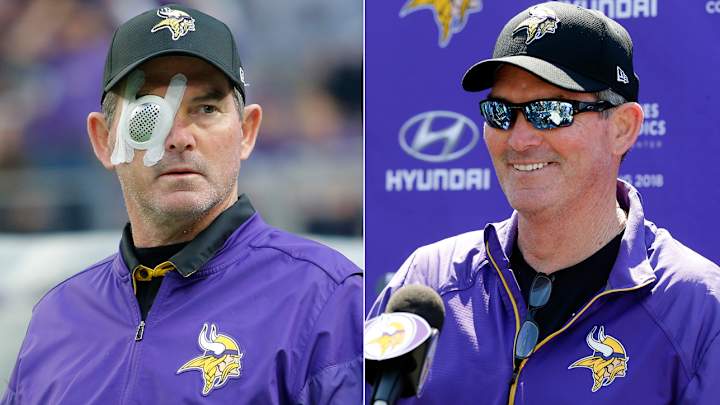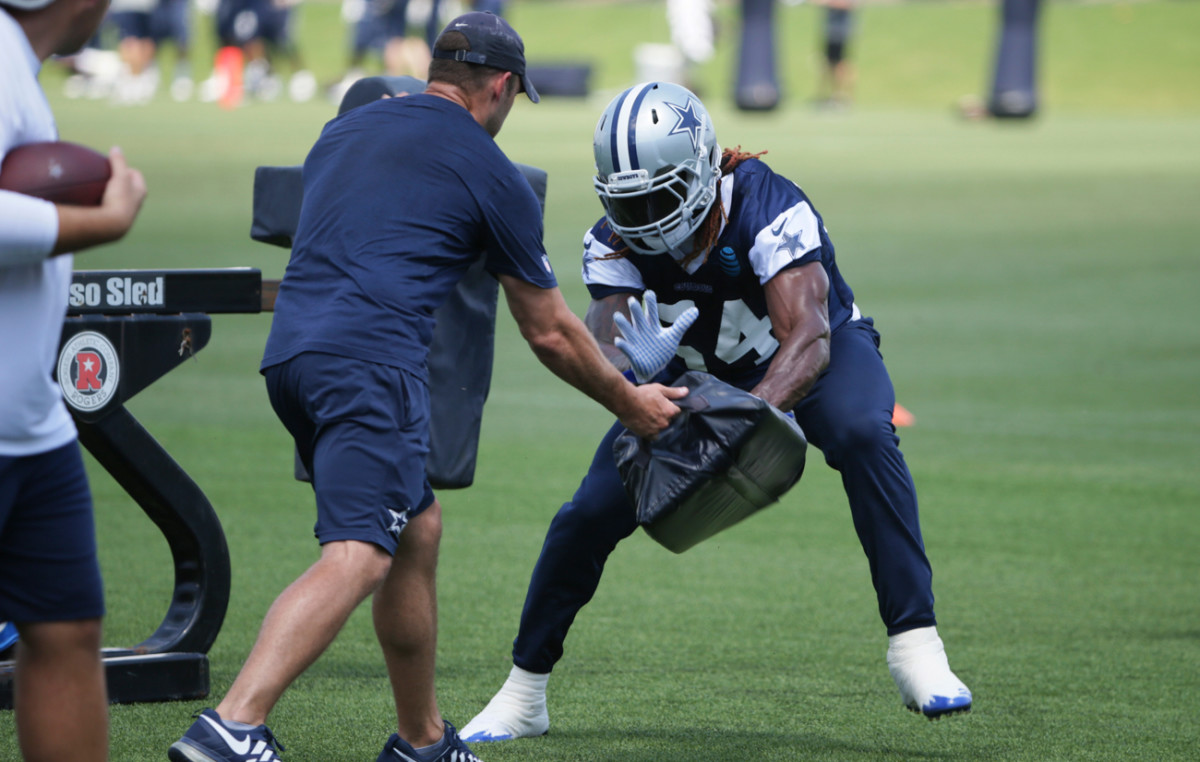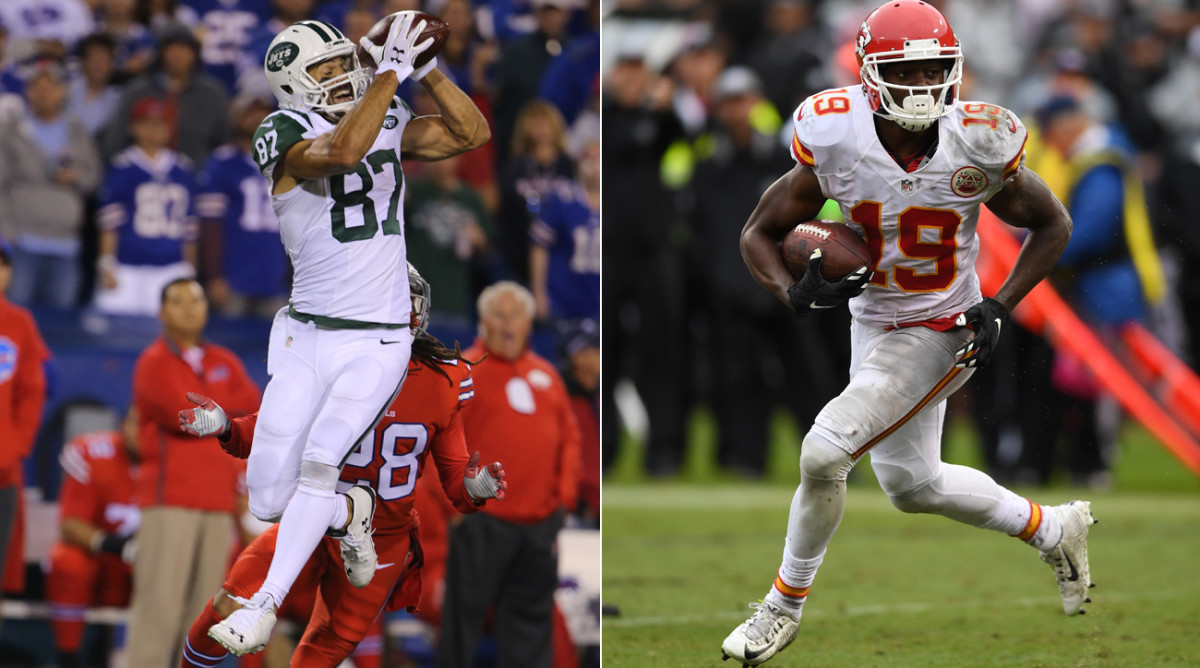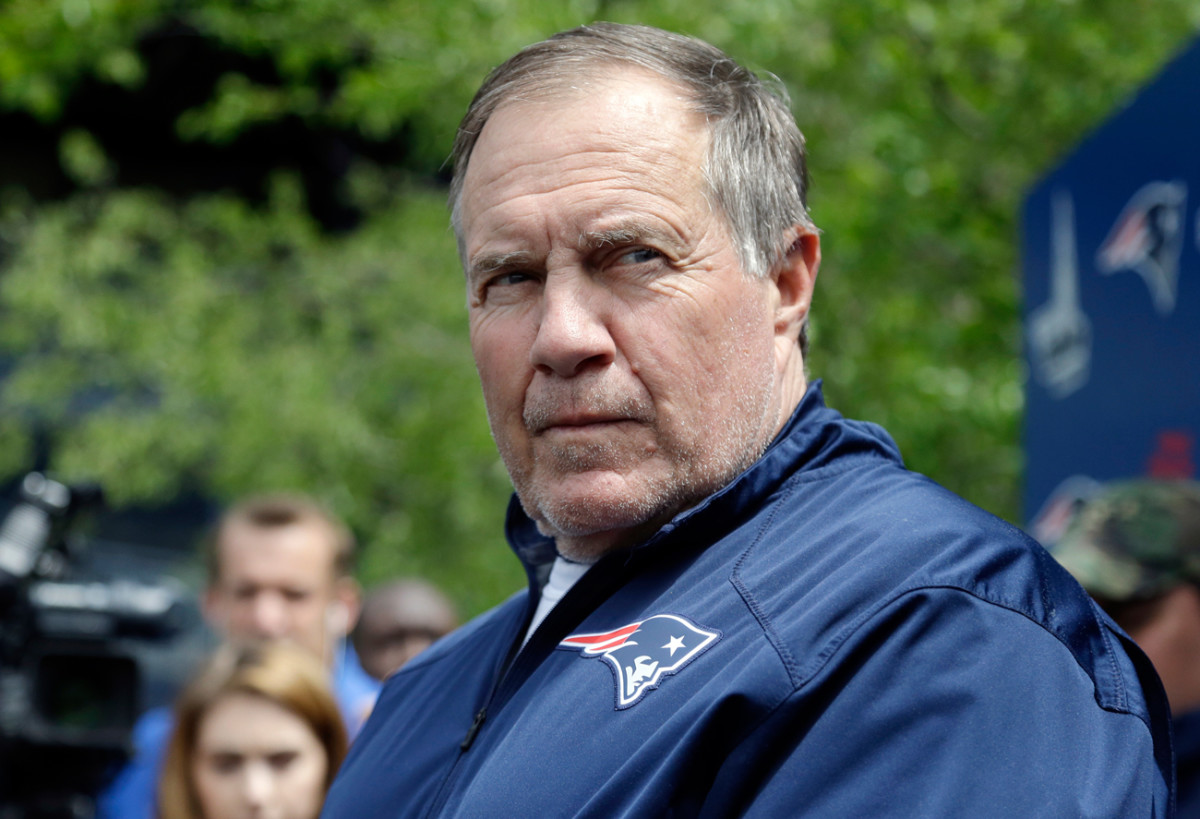Mike Zimmer Sees Vikings From Different Perspective

There were days last year when Mike Zimmer had a TV wheeled into his office and set at eye level to watch film with the Vikings defensive coaches, because he was told he shouldn’t look up. There was the switching between reading glasses and sunglasses. He’d have to flat, face down, for 24 hours, following all those eye surgeries. And he’s slept on one side for the past six months.
With eight vision procedures now in his rear-view, I asked the Minnesota coach if he regretted sticking it out last season.
“Part of my nature, I’m always talking to our team about being tough,” Zimmer said. “That’s the culture I want to present here. And I thought it’d be counterproductive if, the first time something happens to me, I go in the tank. A lot of it had to do with that. I continued to push through it, and I really didn’t do anything I wasn’t told to do. Maybe this last time, I was told to stay out of a little more than I had in the past.
“But it wasn’t anything where [doctors] said, ‘You shouldn’t go to work or do this or do that’, and then I did it. They knew the situation and they allowed me to be a little more aggressive. I don’t know. Maybe that wasn’t the right thing.”

In this week’s Game Plan, we’ll cover the Jets’ rebuild, the Falcons defensive player you might overlook, the Panthers’ optimism in a reclamation project, the patch of grass that defines the Patriots franchise and its natural response to a fifth championship in 16 years, and more.
We’re starting with the Vikings, who had as much upside as any in the NFL at the end of last year’s training camp. But bad luck played a big role after a 5-0 start melted down into a disappointing 8-8 finish. Now behind a rejuvenated leader, the question is how will the 2017 team respond.
That 3-8 finish, by the way, was pretty justifiable considering the circumstances. The Vikings lost Teddy Bridgewater to a freak injury days before the opener, had their two opening-day tackles miss 26 games between them, had the face of the franchise on the shelf for all but three games, and switched offensive coordinators in October. And that’s before we get into Zimmer’s torn, then detached retina.
Now he’s back after a two-week break (doctor’s orders) in the aftermath of what he hopes was his final surgery. It’s easy to forget now that the Vikings were considered a burgeoning powerhouse last summer, barreling towards Year 3 of the Zimmer Era. What’s interesting, to the coach at least, is that his players haven’t.
“The one thing about this team, when I read all the things about the Vikings’ collapse—They were terrible at the end of the year—if you go out and watch us practice, this team doesn’t think that,” Zimmer says. “This team thinks they’re the 5-0 team, not the 3-8 team at the end of the year. That’s good to see, they have a lot of confidence in what they’re doing. Now we have to do it on Sunday, but that’s been really good.
“They haven’t changed their mentality and said, ‘we’re not this’ or ‘we’re not that’. They’re not listening.”
Zimmer does want them to listen to his belief that it wasn’t the injuries that were the Vikings’ undoing, or the coordinator change, or his personal situation. It was, as he sees it, on the players and coaches themselves, and he’s put his own name at the top of the list.
“We went from doing so much right the year before—penalties, things inside the red zone—to where we just couldn’t overcome ourselves,” he continued. “I felt like a lot of that was on me, I didn’t do enough to help this team. … It wasn’t that we weren’t good enough to win. It was we couldn’t beat the Vikings. That was the issue. It was the Vikings beating the Vikings a lot of times.”
And that’s where the focus has been this spring—conveying and digesting the message that the football suicide that became routine down the stretch of 2016 won’t be tolerated in 2017.
Now, that’s not to say that it won’t take a little more than that to contend to become the first team to play a Super Bowl in its home stadium. Zimmer feels good about the defense, returning mostly intact, but the offense has undergone a pretty serious overhaul.
Pat Shurmur had “interim” removed from his coordinator title; Riley Reiff and Mike Remmers are in and Matt Kalil and Andre Smith are out at tackle; and Sam Bradford is entrenched at quarterback. (On what will happen when Bridgewater gets healthy, Zimmer said: “He’s still got a long way to go. So we’ll worry about that later. Sam’s the quarterback, and I think he had a good spring. … When Teddy gets back, we’ll worry about all that.”)
Behind all those guys, instead of Adrian Peterson, will be Oakland import Latavius Murray and probably plenty of electrifying rookie Dalvin Cook, who slipped into the second round of the draft due to a slew of off-field issues that, the Vikings hope, will be eased by the fact that he’s more than 1,500 miles away from his native South Florida.
And while Zimmer will summarize all that by saying, “I don’t think we lack confidence defensively, and offensively we’re trying to gain the confidence,” he’s quick to reiterate that talent was never the issue.
“This spring isn’t about winning the Super Bowl,” he says. “This spring is about trying to correct the mistakes we made last year. We had 16 penalties in the red zone last year that caused us to not score points. We lost four games by six points or less. All these little things add up and that’s what I’m trying to get this team to understand.”
The little things are important for Zimmer and his eye, too. As it stands, he’s going home between 3 and 3:30 p.m. daily—he’ll be at practice, meet with the team, watch tape with his assistants, then take off—as a precaution as the gas bubble dissipates in his eye. He skipped the team golf tourney Wednesday. He gets texts from his doc as a reminder: You’re almost home free, don’t screw it up by going crazy at work!
Zimmer is trying to be smart, and he appreciates—and has gotten a kick out of—all the support he’s gotten. When he passed through Cincinnati two weeks ago, his old boss, Bengals coach Marvin Lewis, said he’d make sure to come by and see him. Zimmer’s response: “Marvin, I’m not dying.” Meanwhile, the reverend that lives next door to his Kentucky ranch told him he had the congregation praying for him each Sunday.
“I’ll take everything I can get,” Zimmer jokes now.
He’s also gotten letters from fans, and not just Vikings fans, who have gone blind or wound up with a more arduous string of surgeries resulting from retina problems. Those notes made him concede, “I probably should’ve treated it more seriously than I did.”
But mostly, Zimmer’s just looking forward to camp where, barring any further setbacks, the doctors have told him he’ll have full clearance to do the job the way he’s accustomed to doing it every summer. He says he learned from the experience. If you talk to him, though, and you know him, he hasn’t really changed much.
“There was never a time where I thought I’d have eight surgeries,” Zimmer says. “There was a time when I thought it’d be cleared and ready to go right away. You know, so many things changed with my eye. I don’t know if it was the extra work I was doing, or it just happened that way. But the plan changed numerous times through the surgery.
“They were going to put gas bubbles in my eye after the first detachment, and next thing you know, we’re using an oil, so I could fly and continue to do my work. And complications happened after that. So I don’t think the doctors did anything wrong. I didn’t work any less than I normally do and that’s probably what I should’ve done. I just felt like I owed an awful lot of people to be here and do my job.”
On his mind now? Not the eye, so much as giving all those people a happy ending to this story.
* * *
FIRST AND 10

1. I know Jeremy Maclin is in Baltimore on Thursday, but the Ravens are looking at a number of options at the position. Don’t rule out Eric Decker.
2. Bob Stoops’ departure from Oklahoma is even more interesting when you consider there had been rumblings over the past five years that he wanted to give the NFL a shot.
3. The recent terror attacks in the United Kingdom will be discussed by NFL officials over the next couple of weeks as they finalize plans for security for the four International Series games set to be played in London this fall.
4. The Giants need for improvement at linebacker is well-documented, so the strong spring of second-year middle linebacker B.J. Goodson is worth noting here. Devon Kennard has turned in a few solid weeks of work too.
5. New free agent David Harris could potentially help the Giants, but the most interesting fit for him might be the linebacker-needy Raiders. The issue would be how much juice Harris has left in his legs. Oakland needs a guy who can run.
6. One piece of encouraging news out of Cardinals minicamp is the veteran leadership, particularly from linebacker Karlos Dansby and incoming safety Antoine Bethea.
7. Hard not to root for Cowboys linebacker Jaylon Smith, but the team still views anything it gets from him as a bonus. The real challenge for Smith, playing with an AFO (ankle-foot orthosis), comes once he puts on the pads.
8. The quarters rule—the one keeping players, like Christian McCaffrey, whose schools are in session out of spring camps—isn’t antiquated. It’s just dumb. I’m all for guys finishing school. But as a practical matter, players are dropping out before the draft anyway.
9. I think Pete Carroll did what a lot of coaches have with Colin Kaepernick. And that is, he said, “I’ll take the guy who arrives as a line in agate type in the transactions.” It’s not black-balling. It’s reality of how coaches want their backups.
10. If you haven’t seen the Shareece Wright Uber story, be sure to check it out. And good on Wright for taking care of his driver to the level he did. Only question I have there: Isn’t $632.08 a steal for a chauffeur from Chicago to Buffalo?
* * *
FOUR DOWNS

1. The Jets’ rebuilding is in overdrive. We knew the Jets were in the midst of overhauling a roster that got old in a hurry in 2016. But the moves this week to cut long-time team leader and reliable inside linebacker David Harris and veteran receiver Eric Decker went beyond the well-established youth movement. To plenty of people, it confirmed suspicions that many in the league have harbored over the past few months that owner Woody Johnson, moreso than the football people, has his sights set on the No. 1 pick in the 2018 draft and next year’s class of quarterbacks, with money being secondary to that.
Now, to be fair, there’s no question the team needed to get younger, and that course wasset by GM Mike Maccagnan. And as a team source explained it, Maccagnan has the backing of ownership here (as ownership lusts over that pick), like Raiders owner Mark Davis had GM Reggie McKenzie’s back through a rocky few years. Truth is, the comet-crossing-the-sky season of 2015 only served as the precursor for 2016, when the shaky foundation that ex-GMs Mike Tannenbaum and John Idzik left for the current regime collapsed. The team entered last season carrying 12 players in their 30s on the 53-man roster (and a 13th on the PUP list). Ten of the 12 started on Opening Day. Nine months later, the Jets have just five guys 30 or older on their 90-man roster, and that number remains subject to change.
In the end, if the Jets wind up with USC’s Sam Darnold or UCLA’s Josh Rosen or Wyoming’s Josh Allen, it might not matter. But in the short term, gutting the roster doesn’t come without risk. It certainly puts Todd Bowles in the precarious position of trying to win in Year 3 with a team that has the look of a start-up program. And there’s risk in the kind of environment created for young players like Leonard Williams and Darron Lee and Jamal Adams that Mike Maccagnan and Co. envision being at the foundation of a contender in a couple years. If things go off the rails in November, and the team implodes (and remember, combustible parts like Mo Wilkerson and Sheldon Richardson are still there), what kind of toll will it take on their development? All of this is worth considering.
Again, in an expected banner draft for quarterbacks, if the Jets find their long-term answer to the game’s most important team-building question, then maybe the rest doesn’t matter. The Colts certainly wouldn’t give back Andrew Luck for getting to skip their disastrous 2011. But the scars left in the interim, and the message this is sending, shouldn’t be ignored.
2. The Falcons defense is set to fly. Most of the stories this time of year revolve around guys who are staying away from OTAs because of brewing contract disputes. Too often, we overlook the ones that go the other way, and let’s just say that how Ricardo Allen has handled this offseason hasn’t gone unnoticed by the Atlanta staff.
Allen was drafted as a corner in 2014, got cut and was deemed a bit of a misfit for Mike Nolan’s defense, then stuck on the practice squad, and got promoted at the end of his rookie year. Then, in 2015, Dan Quinn arrived and moved Allen to the same free safety spot that Earl Thomas played for Quinn in Seattle, and Allen has started 30 games since. This offseason has been the first Allen has been eligible for a new contract, and rumors ran hot before the draft that the Falcons might fill the free safety spot with someone like Marcus Williams (who landed with the division rival Saints). And through all of that, as one club source said, “We’ve been so impressed with his professionalism and his ability to continue to learn that free safety spot. He’s one of the leaders for us on defense now, and a smart guy to have back there.”
Allen’s continued development into that important role in Quinn’s scheme shouldn’t be overlooked, because it’s one of a number of pieces that could turn the unit into the type it has shown promise of becoming (most prominently early in the Super Bowl). A couple weeks back, GM Thomas Dimitroff told me the current roster is the best one Atlanta has had in his decade in charge. “We’re at a spot right now that, quite honestly, it is the most talented overall,” he said. “As a whole group, I’m wildly excited about where we are.” And the reason why is the improvement of the defense, with a potentially tenacious front boasting two edge rushers, in Vic Beasley and rookie Takk McKinley, with 40 times in the 4.5s, a hyper-athletic group of linebackers, an improving crew of corners with Desmond Trufant returning, and Quinn’s Kam Chancellor 2.0, Keanu Neal. Having a really strong centerfielder to tie it together would certainly help the group build on the end of last year, and get past the collapse at the very end. And it looks like, after 30 starts at the position, Allen is getting there.
3. Where was the issue with Jeremy Maclin? The timing of the Chiefs’ move to whack their incumbent top receiver—they cut Maclin on June 2—sure smelled funny. But it’s actually pretty simple. Kansas City was going to need cap space to sign its rookie class, and with a roster featuring a few high-salaried veterans, it made sense to wait and see how things shook out early on in the offseason program. And the Chiefs got the sort of progress from their younger group at receiver to create the flexibility to move on from Maclin and his $10 million salary for 2017.
As for what’s next in the Chiefs receivers group, moreso than Tyreek Hill—who’s electric but more of a gadget weapon—the name to watch is DeMarcus Robinson, a 2016 fourth-rounder who had good but not great production for the quarterback-troubled Florida teams he played for in college. The Chiefs like his route-running and ball skills, as well as the fact that Robinson is really natural catching the ball.
Meanwhile, Maclin was in Buffalo this week and will be in Baltimore on Thursday, and there’s plenty of evidence he’s still got something left in the tank. One contender discussed internally the idea of moving on from a prominent and productive veteran receiver on a reasonable contract and replacing him with Maclin. And it could still happen, which tells you that there’s still very much a place for the eight-year vet somewhere in the league. As one NFC pro scouting director sees it, “I don’t think he’s a true No. 1, but he still has juice left. Surprisingly, he made the contested catch look easy last year.”
4. A career revival for Matt Kalil in Carolina? Should Matt Kalil stay healthy this year—and that’s a big if—he’s set to be the fifth full-time left tackle in Panthers GM Dave Gettleman’s five years as general manager, following Jordan Gross (2013), Byron Bell (2014), Michael Oher (2015) and Michael Remmers (2016). And based on what Carolina has seen early, there’s reason for optimism that Kalil can come closer to realizing the potential that made him the fourth pick in the 2012 draft than he did in five years as a Viking. And maybe stop the revolving door. “He’s coming on strong,” said one team staffer. “You see him in shape, and you see the athleticism. And he’s starting to get a feel for what we’re doing.”
A couple other factors, those in the building think, will make a difference. First, the presence of Kalil’s brother, five-time Pro Bowl center Ryan Kalil, should give him a comfort level with the guys around him, which is important for offensive linemen. Second, Panthers run-game coordinator John Matsko has been a difference-maker for incoming veteran linemen in the past—that’s certainly been the case with Oher—and so his work with Matt Kalil is worth watching.
Now, the flip side is the questions about the big tackle’s edge and passion for football that dogged him during his Viking days, and the idea that those are things you can’t coach. But going to Carolina would certainly seem to give him Kalil his best chance. If it works out, then the Panthers have a chance to put to bed what was internally considered the biggest reason for Cam Newton’s offseason—the decline of that line.
* * *
OFFSEASON LESSON TO TAKE WITH YOU

So I went over to Foxboro on Wednesday to check out the world champions, and I could give you my boilerplate observations ... OK, fine. Quickly …Tom Brady still looks significantly better than Jimmy Garoppolo; Brandin Cooks was electric down the field in practice; undrafted rookie slot Austin Carr could be a fun summer watch; and the Pats’ secondary has a chance to be downright nasty.
But I figured we’d focus on a well-worn patch of grass on the southeast corner of the team’s practice fields.
Why? Because I really don’t recall seeing any other NFL team doing what the Patriots were at the conclusion of their minicamp practice on this sunny New England day, and it’s honestly what you might expect to see at the high school down the street. The assembled group, including many who will be getting their championship rings at a ceremony this weekend, was running hills.
It’s one thing to see this during a strength-and-conditioning session. It’s another to see a pro team doing this after a full practice. And yet, there the Pats were, disappearing down the hill and then coming screaming back up in groups.
The message?
“Uh, get in shape and get in shape now,” said new Patriots tight end Dwayne Allen, who came from the Colts in a March trade. “That’s the message. Running the hills, it’s been quite an adjustment. But anything can seem like an uphill battle. Long as you take it day by day, and keep taking steps towards your goal, you’ll be OK.”
Our offseason lesson for this week: With pelts on the wall, Bill Belichick can get away with more of this than any other coach, and it’s absolutely part of the Patriots’ cultural advantage.
In other locales, without all those wins on the ledger, this sort of practice might be seen as High School Harry BS. Not in Foxboro.
New Patriots corner Stephon Gilmore told me he hasn’t been subject to post-practice conditioning runs since college. Fresh-off-the-free-agent-market receiver Andrew Hawkins went a step further, saying he couldn’t remember the last time he’d gone through the sort of running that all of us who played high school football used to dread.
“I think high school was the last time I conditioned after practice, because as receivers we run so much,” said Danny Amendola, a fifth-year Patriot. “But since I’ve been here, late in the season and into the playoffs, I’ve noticed it. When you put it in the bank, like Coach Belichick says when you’re on the hill, it really helps out. You notice your endurance down the line.”
The hill run itself is 60 yards long, and Amendola says that while the Patriots may not do it after every single practice from May through January or February, they do it close enough to all the time that, “personally, I expect the hill every day.” On a good day, they may run seven sprints up it. If Belichick thinks they’re dogging it or need more, the number can reach 12.
“It’s tough, after a full day of practice, going over there,” Hawkins says. “But everything pays off, so you can’t question it. I think it’s great.”
And yes, this would all seem silly somewhere else. Because it’s happening here, though, it’s hard to doubt—especially when 40-year-old Tom Brady is chugging up hills too. The guys who’ve been around aren’t shy about buying into it.
“I feel like in the offseason, when we’re not playing games or beating each other up, a lot of teams are at the same conditioning level,” Amendola says. “And then once it gets into the season, and then on into the playoffs, that’s when you see the hill in our team.”
So maybe this isn’t why the Patriots were able to rally from 25 down on the last day of the season. But it probably didn’t hurt.
• Question or comment? Email us at talkback@themmqb.com.
